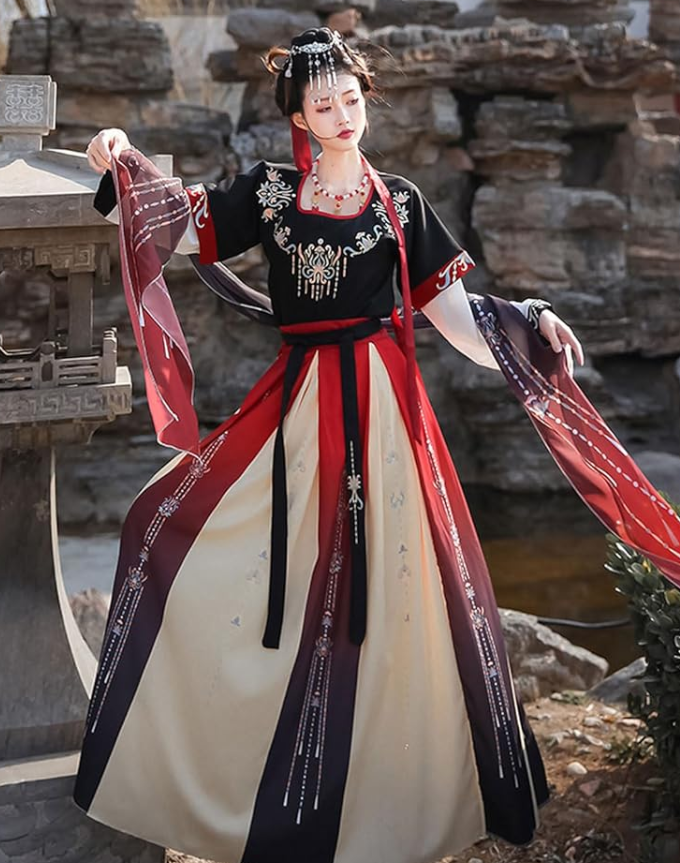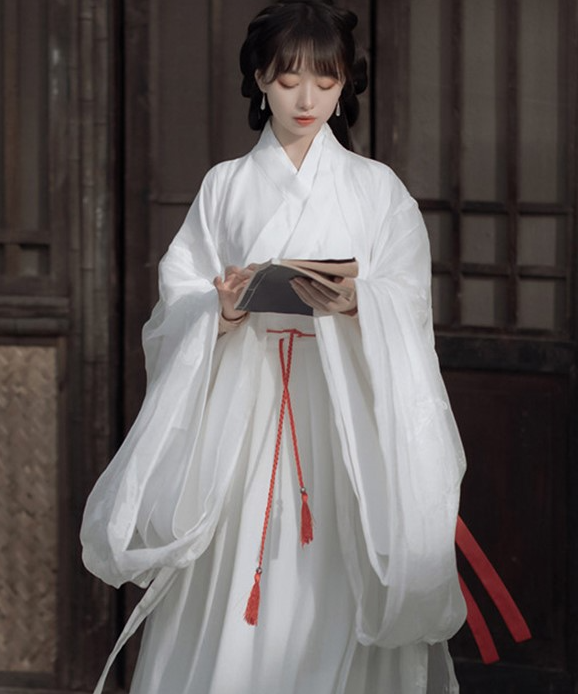Yes, Hanfu is generally comfortable to wear, thanks to its breathable fabrics and flexible styles that adapt to different occasions and climates.
Types of Hanfu
Shenyi
Shenyi is considered one of the most formal styles of Hanfu. It consists of a top and a bottom that are sewn together into a single piece. Traditionally, Shenyi is made from high-quality materials such as silk and is adorned with intricate patterns and embroidery. It is often worn on ceremonial occasions and is highly regarded for its elegant and graceful appearance. For more information, you can read about Shenyi on Wikipedia.
Comfort Level
Shenyi offers a loose fit that allows for breathability and range of motion. However, the high-quality materials and complex designs might make it less practical for everyday wear.

Ruqun
Ruqun is a two-piece outfit consisting of a blouse (Ru) and a skirt (Qun). This Hanfu style is more commonly seen among women and is known for its versatility. The blouse and skirt can be made from various materials such as cotton or linen, making it easier to adapt to different seasons and occasions. Learn more about Ruqun on Wikipedia.
Comfort Level
Ruqun is known for its comfort and adaptability. Its separate top and bottom make it convenient for different activities, from sitting to walking and even running.
Zhiduo
Zhiduo is a type of men’s Hanfu that resembles a long robe. It is characterized by its crossed collars and a front panel that wraps around the body. Zhiduo can be made from materials like silk or linen, depending on the intended use and climate. If you are interested, you can find more information about Zhiduo on Wikipedia.
Comfort Level
Zhiduo offers a lot of freedom in movement due to its flowing structure. It can be very comfortable when made from breathable materials, making it suitable for a variety of activities and weather conditions.
Comparison with Other Traditional Dresses
When comparing Hanfu with other traditional dresses like the Japanese Kimono or Korean Hanbok, Hanfu generally stands out for its variety of styles and adaptability to different seasons. While Kimonos are generally heavier and have more layers, and Hanboks are designed with unique structural elements like the jeogori (jacket) and chima (skirt), Hanfu offers a range of options in terms of materials and designs, catering to individual comfort and needs.
Comfort Level
Compared to other traditional outfits, Hanfu offers a broader range of comfort options because of its multiple styles and material choices. This makes it easier for wearers to choose a Hanfu style that is both aesthetically pleasing and comfortable.
Materials Used in Hanfu
Silk
Silk holds a special place in the realm of Hanfu, not only because of its historical significance but also due to its luxurious feel and aesthetic appeal. Known for its smooth texture and lustrous shine, silk provides a unique sense of elegance and sophistication. In ancient times, silk was often associated with royalty and the upper classes. The material works well in both hot and cool climates as it can keep you warm in winter and cool in summer. For more details, you can refer to Silk on Wikipedia.
Comfort Level
Silk offers a soft and smooth texture against the skin, making it comfortable for extended periods. However, its delicate nature means you need to handle silk Hanfu with care to prevent damage.
Linen
Linen is another popular material for Hanfu, especially for summer wear. Made from the fibers of the flax plant, linen is breathable, lightweight, and quick to dry. Unlike silk, linen has a more rustic appearance and texture, which some wearers find to be more “down to earth” and natural. Learn more about Linen on Wikipedia.
Comfort Level
Linen is highly breathable and wicks moisture away from the body, making it ideal for hot and humid climates. Its natural fibers provide a cooling effect, ensuring comfort during the warm seasons.
Cotton
Cotton is a versatile and comfortable material often used in more casual styles of Hanfu. It comes from the cotton plant and offers softness and breathability. Cotton is less expensive than silk or linen, making it a more accessible option for everyday wear. You can read more about Cotton on Wikipedia.
Comfort Level
Cotton is perhaps the most comfortable of all the materials used in Hanfu. Its softness and breathability make it ideal for extended wear, and it is also easier to maintain than silk or linen.
Cultural Context
Occasions for Wearing Hanfu
Hanfu is not just a piece of clothing but a cultural symbol that carries historical and social significance. Historically, people wore different styles of Hanfu according to various occasions, from casual outings to formal ceremonies. For example, Shenyi often appears at weddings or important cultural ceremonies due to its formal and elegant nature. On the other hand, Ruqun and other less formal styles are suitable for everyday activities and casual gatherings. For festivals like the Lunar New Year, Mid-Autumn Festival, or the Dragon Boat Festival, wearing Hanfu becomes a way to connect with traditional customs. You can learn more about the Cultural significance of Hanfu on Wikipedia.
Comfort Level
The occasion often dictates the choice of material and style, impacting the overall comfort. For instance, you may choose a silk Shenyi for a wedding but opt for a cotton Ruqun for a casual day out, each offering its own level of comfort suitable for the event.
Hanfu in Modern Day
The revival of Hanfu in modern times has added new dimensions to its cultural context. Today, people not only wear Hanfu for traditional ceremonies but also integrate it into daily fashion. It has become a style statement and a way to express cultural pride among younger generations, especially in urban settings. Social media platforms are buzzing with Hanfu enthusiasts who share styling tips, new designs, and even DIY Hanfu tutorials. The modern-day interest in Hanfu also crosses borders, attracting international attention and diverse audiences. You can read more about the Modern Hanfu movement on Wikipedia.
Comfort Level
Modern-day Hanfu often incorporates more user-friendly materials and designs to enhance comfort. Brands and designers are increasingly considering factors like breathability, ease of movement, and maintenance to cater to contemporary lifestyles.
Physical Comfort
Breathability
When it comes to comfort, the breathability of the fabric is a crucial factor, especially in a hot and humid climate. Linen and cotton, for example, allow for better airflow, making them ideal choices for summer or tropical conditions. Silk, while less breathable than cotton or linen, does offer some level of air circulation due to its natural fibers. If you’re interested in learning more, check out the textile science section on Wikipedia.
Comfort Level
Linen and cotton are generally the most breathable, making them comfortable for long periods, especially in hot climates. Silk can also be breathable but may not be the best choice for extremely hot or humid conditions.
Flexibility and Range of Motion
Different styles of Hanfu offer varying degrees of flexibility and range of motion. For instance, Ruqun, with its separate top and skirt, allows greater freedom of movement compared to Shenyi, which is a one-piece outfit. Activities like walking, running, or even practicing martial arts are more convenient in styles that offer more flexibility. You can read about the physical aspects of clothing on Wikipedia.
Comfort Level
Ruqun and Zhiduo are often cited as the most flexible styles, ideal for a range of physical activities. Shenyi, while elegant, may restrict movement due to its one-piece design.

Seasonal Variations
The comfort of Hanfu can also be subject to seasonal variations. For example, thicker materials like brocade might be chosen for winter Hanfu, while lighter fabrics like linen or thin silk are preferred for summer. The versatility of Hanfu styles allows adaptation to different climates and seasonal changes. More can be learned about seasonal clothing on Wikipedia.
Comfort Level
Lighter fabrics like cotton and linen provide comfort in hot climates, while heavier materials such as brocade are more suited for cold conditions. Some Hanfu styles can be adapted for all seasons by layering or removing pieces.
Psychological Comfort
Sense of Belonging and Identity
Wearing Hanfu is not just a matter of physical comfort; it also plays a significant role in shaping one’s sense of belonging and identity. Donning this traditional attire can evoke a strong connection to cultural roots and heritage, especially for people of Chinese descent. For many, it serves as a tangible link to a history and culture that they may not interact with on a daily basis. Wearing Hanfu can thus provide emotional comfort by instilling a sense of belonging and reinforcing cultural identity. You can learn more about the psychology of clothing and identity on Wikipedia.
Comfort Level
The sense of cultural connection that comes with wearing Hanfu can provide deep psychological comfort for some individuals. However, the extent of this comfort can vary depending on personal perspectives and experiences.
Social Perception
The way Hanfu is perceived socially can also affect the psychological comfort of the wearer. In settings where Hanfu is appreciated and respected, wearing it can elevate one’s social standing and foster a sense of pride. However, in places where traditional attire is less understood or even stigmatized, wearing Hanfu may result in unwanted attention or judgment. As social perception is a complex topic, you may find it interesting to read about social psychology and clothing on Wikipedia.
Comfort Level
The psychological comfort derived from social perception is subjective and can vary widely. While some may find the attention and curiosity Hanfu generates exhilarating, others may feel uncomfortable or self-conscious.







